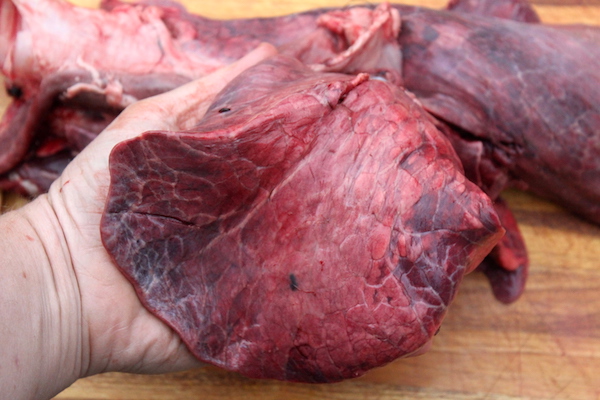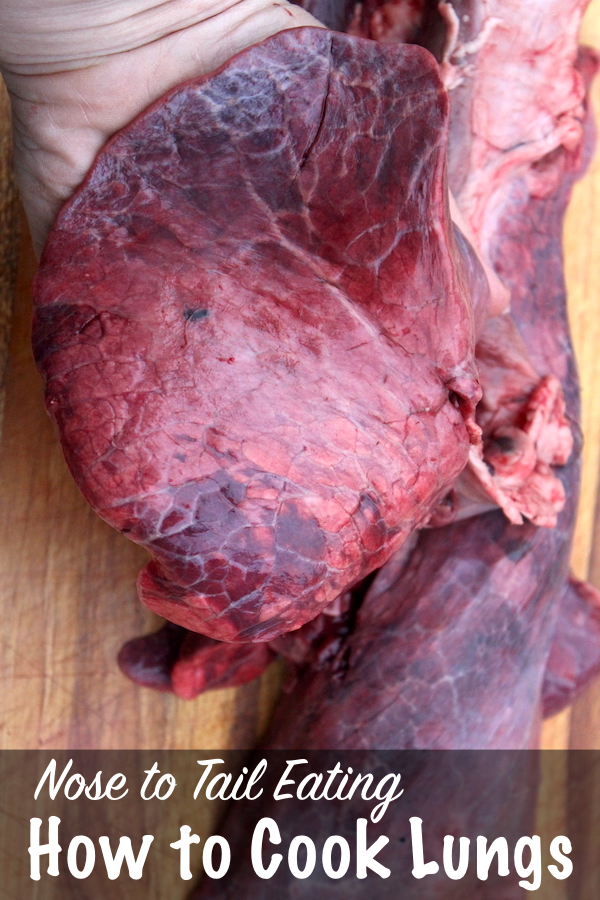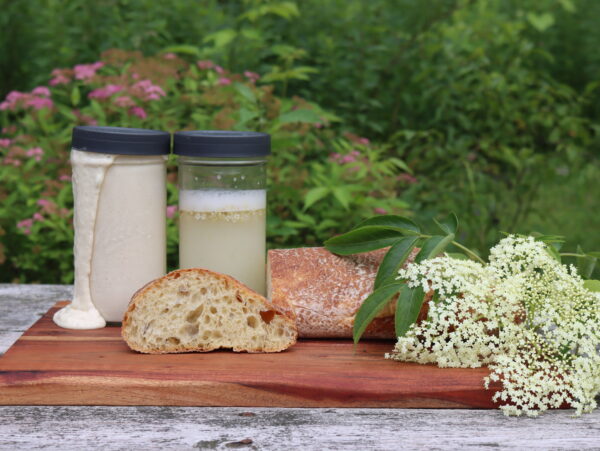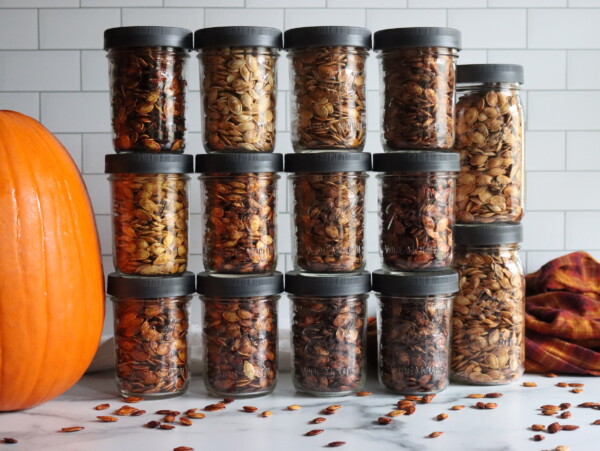Affiliate disclosure: This post may contain affiliate links. Please see our Privacy Policy.
While you’ll often hear talk about how our ancestors used every part of the animal, even with the new revival in “nose to tail eating” plenty of parts are still left out.
In the US, you’d be hard pressed to find anyone serving lungs, even though they’re a common ingredient in many countries. So how do you cook lungs anyway?

It was just a normal weekday morning at my house, the little ones bouncing about the living room and my husband bundled up to go feed the boiler. Five minutes later he walked back into the house carrying a huge armload of organs and dripped them across the living room floor before plopping them on the kitchen counter.
One of our neighbors had just shot a deer, and it had run onto our land before collapsing between the house and boiler shed. He was part way through gutting it when my husband came out, and he did the neighborly thing and offered a piece to share, namely all the organs above the diaphragm. In Europe, this is referred to as the “pluck” and it’s not uncommon to find fresh lamb pluck for sale in one big bundle at lamb harvest time.
Deer heart is a real treat, arguably one of the very best cuts. Trim it into steaks, give it a quick marinade and cook medium rare for some of the best steaks you’ve ever had.
Deer liver is not so spectacular, and you have to be a pretty hardcore liver fan to cook it up. We cooked it anyway and made a downright decent venison pate.
Now comes the real tricky part. How do you cook lungs? I knew they were edible because years ago I came across a British butcher’s cooking video, where he shows you how to make an old school dish called “butchers faggots.”
They’re basically meatballs made by grinding all the parts that are hard to sell in a butcher’s shop and then wrapping the whole thing in lacy caul fat (visceral fat).
He’s since posted a new video, specific to making butchers faggots with deer pluck. The lungs, he says, “have no nutritional value but they do add a lovely texture, making the faggot lighter.”
Since I had already cooked up the heart and liver one way, I needed to find a way to cook just the lungs on their own. I’m skeptical that they have “no nutritional content” but either way, a full pluck of butcher’s faggots was off the menu.
Eating Lungs in the US
I kept searching for recipes, but time and again, anytime I find recipes for lungs they were British, Italian or Asian recipes. Not one old school country recipe from the US.
That struck me as odd, so I pulled out my old copy of Joy of Cooking from the 1970s which has all manner of strange included in its pages. Things that were once common on the American table but have fallen out of favor, like squirrel recipes, and even detailed instructions on how to clean a possum.
That’s where I found the answer…it’s illegal to sell lung in the United States.
After providing detailed instructions on how to cook just about every part of any animal imaginable, the book notes that, “although some of those formerly used, like lungs, are now outlawed.”
What?!?! That’s just strange. Why?
A bit more research, and there’s actually a good answer. Quite frankly, the modern slaughterhouse is just not an environment that can ensure a lung is removed in a clean and uncontaminated manner. If the lungs come into contact with the bowels, there’s just no way to really clean them since they’re full of tiny passages.
When just about any other part of the cow falls on a shit-stained floor, you can rinse it off. Drop a lung and it’s just full of nasty. Kind of makes you want to go pick up some mass market slaughterhouse meat at the grocery store tonight, no?
In any case, you’re out of luck buying a lung in the US, thus it’s fallen out of our culinary heritage. If you want a lung, you’ll have to carefully pull it out of the animal yourself, or find it on the menu overseas. If you do happen to have a fresh clean one as I do, here are a few ways to cook a lung.
Traditional Italian Lung Recipes
An Italian recipe, Coratella di Abbacchio Con Carciofi, uses the pluck of a fresh lamb and cooks it with artichokes. It’s a lamb harvest tradition, and it’s often prepared around easter. I found a writeup that cooked it straight out of an old Italian cookbook, and she describes the cooking process as she’s reading the book:
“And this recipe remains one of my all-time favorites if only for one line she uses to describe how to tell if the lungs are done. When you hear the “sibilo caratatteristico,” the characteristic whistle, you know the lungs are done. I remember reading this recipe for the first time, thinking I didn’t understand it. The lungs were going to whistle? Yes, in fact, they do. A high-pitched whistle as the air valves are closing means that the lung is done and it’s time to add the heart, then the liver. “
Unmentionable Cuisine also describes an Italian recipe for lung with beans (Polmoni di vitello con fagioli):
“Brown a sliced onion, some diced salt pork, some crushed garlic, chopped parsley, and chopped celery in a mixture of olive oil and lard. Add cubed calf’s lungs and brown them thoroughly. Add a wineglass or so of white wine, some peeled tomatoes, salt, and pepper, and cook about a half hour. Add a generous quantity of previously cooked kidney beans and a little water, cover, and simmer for about an hour. Add some chopped sweet basil the last few minutes of cooking.”
Romanian Lung Recipes
Similar to the lamb pluck dish in Italy, Romania also has a big meatloaf or casserole-style dish that includes lungs called Gusita Sau Drob De Miel. It’s a traditional Easter meal, and it comes together in a big loaf pan of minced lamb everything. There are some really beautiful pictures of the dish here, almost lovely enough to make you forget that it’s made with all the less desirable bits of the animal.
Traditional French Lung Recipes
A recipe from France, Unmentionable Cuisine describes Calf Lung Provence Style and mentions that it’s a good lung recipe for beginners to enjoy. They also note that it works just as well with pig or lamb lungs.
For Calf LungProvence Style (Mou de veau a la Provençal), “Cut beaten calf’s lungs into thin pieces and poach them for 30 minutes in salted water. Drain and dry them. Dredge with seasoned flour. Add them to a pan containing chopped onions fried in oil until golden and cook together until the lungs begin to brown. Add chopped tomatoes, chopped parsley, crushed garlic, salt, pepper, and a generous amount of white wine. Simmer for a half hour.”
The book also describes a second French recipe for Calf’s Lung stew (Civet de mou de veau):
“Salt and pepper pieces of lungs and fry them in butter until well browned. Sprinkle with flour, stir well, and cook for a few minutes more (or thicken with blood). Cover with dry red wine or a mixture of wine and stock. Add a bouquet garni and some crushed garlic. Cover and bake in a moderate oven for 1 1/2 hours. Transfer the pieces of lung to a shallow baking dish and add some chopped and fried bacon, diced or whole mushrooms, and a number of small onions (and/or carrots) fried in butter or with the lean bacon. Cover with the strained cooking liquid and return to the oven for an additional 30 minutes. Garnish with croutons.”
Here are a few more French variations:
Scottish Lung Recipes
Most of us have heard of haggis, if only as something to joke about being forced to eat. It includes just about every part of the animal, including lungs. Here’s a traditional haggis recipe, with the lungs and everything. Or, you could always just take the convenience food route and try haggis in a can.
Traditional German Lung Recipes
A German dish called Töttchen is also known as “poor people’s eating” because it combined all the undesirable cheap cuts into one dish. It’s basically a calf’s head casserole, with lung, heart and other offal thrown in to bulk it out.
It’s still served in many restaurants, but more desirable offal cuts like tongue are used to fancy it up a bit. Unmentionable Cuisine includes a basic recipe:
“Simmer a boned-out calf’s head, a calf lung, and heart, an onion stuck with cloves, and a bay leaf in water to cover until the meats are tender. Cut the meat into pieces. Fry chopped onions in butter until golden, stir in some flour, and then enough of the strained stock to make a smooth sauce. Add some white wine and a little sugar. Reheat the meat in butter, pour the sauce over it, and serve with mustard and black bread.”
The dish lungenragout is another traditional German dish, and includes lungs and heart into a savory stew with onions, carrots, parsnips, and celery. Beuschel is the Austrian version, including heart, lungs, kidney, spleen, and tongue in a cream sauce with dumplings.
Chinese Lung Recipes
Lungs, commonly from pigs, are still common in Chinese cooking. Here are a few recipes to get you started:
- Almonds and Pork Lung Soup
- Pork Lung and Bok Choi Soup
- Deep Fried Beef Lungs with Chillis
Other Lung Recipes?
This is more or less a brief survey of lung recipes from around the world, but I know it barely scratches the surface. People have been eating nose to tail for millennia, knowing that pieces wasted would come back to haunt them in times of hunger. Have you eaten lung? How was it prepared?





I’ve chicken-fried deer lung or added it to the ground meat.
Hello, we often had lung on the table at home when I was a kid – some 70 years ago. It was boiled and minced, and some vinegar added. Plus salt and pepper and flour to thicken. Served with mashed potatoes to which chopped brown fried onion was added.
Thank you so much for sharing that.
On the subject of frying lights,
My fathers family were transplanted okies from colgate Oklahoma to the west texas oil fields ,
Every winter in the early 60’s on, we had several families gather up on snowy Ice covered weekend mornings . We would butcher several hogs. The first thing cooked was always the lights (lungs) dredged in milk/ egg and flower just like you would for a chicken fried steak, these were really good to a bunch of hungry folks all pitching in on the killing and butchering,
Years later when we started having Carl miles a game processor in Odessa do our butchering. Carl explained the state would not let him package the lungs. He also went on to explain that any disease the animal ever had was breathed the those lungs.
I steal chicken fry deer lungs any time I have the time to keep the lights if i kill a deer close to the house.
Town snd city boys turn their noise up. But these make a really good sandwich.
Hello Ashley, an interesting read, as a former Vermonter living in Florida, I have been exploring different dishes beyond the same old burgers hot dogs and steak. Looking to reduce my grocery bill and wean off from microwave foods. I’ve always liked Liver and Onions, and have added sweet bell peppers to the dish, along with some favorite spices. I’ve never eaten tripe though have seen it in stores, and have been wanting to try it. I then ran across your Lung post here and never knew lungs were eaten. I look forward to trying it next time I get a deer.
Thanks for sharing. We’re so glad you enjoyed the post.
I’m a little surprised at your comments on deer liver. We find deer liver and onions to be excellent. We simply slice the liver, add onions, salt and pepper then fry in butter. I do clean the liver and rinse well. Lastly the liver is best fixed fresh not frozen.
In Latvia the most common way would be to use it as a filling for crepes. But my grandmother used to mix lung in a liver pate – it was the most delicious liver pate I have ever eaten, it was so light and delicate
We just had the butcher out today to take one of the cows, I always wait around with my buckets to keep the heart, liver, kidneys, tail and tongue. This time I also kept a piece of the lung and fried it up after I cleaned, cut and wrapped everything else for the freezer. It’s an interesting texture for sure. I cubed it, coated with some regular spices (salt,pepper, onion, garlic, paprika, a little chili) fried in pan with butter and a hunk of fat off the liver, added a few splashes of rose wine that was sitting on the counter, and cooked it with the lid on till the liquid ran dry then just browned the edges. Ate it with rice, pretty good. Next time I’ll save more of the lung and add it into dishes with more different textures and other types of meat/veggies.
In Greek cuisine, we make a delicious Easter soup called Magiritsa. It’s made with lamb lungs, heart, kidneys and liver. The organs are cooked with onions, romaine lettuce and dill, and at the end there is a lemon egg sauce that is mixed in. It’s delicious and hearty. I made it for the first time this year and it was fairly easy to make but it has a long simmering time, 2.5 hours.
That sounds very interesting. Thank you for sharing that.
In polish cuisine lung dishes become a bit of a past which is sad because pierogis with lung based filling are absolutely delicious!
We ate ‘liver and lights stew’ at hog killing time in Georgia during the 60s. It was pork liver and lungs cut into 3 inch and 1 inch cubes respectively and boiled with onions, salt and pepper until the liver started coming apart. It was served with rice and buttermilk lard biscuits. And home canned tomatoes from a quart mason jar. My stomach is growling just thinking about it. LBN
Thanks for the post, it was interesting.
I’ve cooked lung already a few times, it was delicious, oversalty one time but it was a mistake,
the texture is what’s the most interesting about this piece after the price, it’s like biting on a cooked
mushroom, nice and soft, almost spongy. And a great aspect i’ve found is that is takes any flavor
you want, originally it’s flavorless, but with a good marinade it is a real delight. Thanks for reading
I’m Peruvian and we eat almost anything (intestines, hearts, brains, lungs, literally anything). We do have a recipe called chanfainita that involves lungs. It can be a bit tricky since I don’t know if you have access to all the spices we use. I found recipes here: https://peruvianfood.com/chanfainita/. It is usually served with rice and potatoes. I had no idea lungs were banned in other countries. Here, it’s one of the cheapest things to buy, as chicken, meat and ironically, seafood can get very expensive. I might be biased, but Peruvian food is amazing, I suggest you try it someday.
According to the USDA data nutritional database LUNGS are high in vitamin c, only spleen has a higher value. A simple use for them – they make a great option instead of bread or crackers to make sage dressing. Cube put in raw or saute then add to one’s dressing… so much more nutritious than bread.
Very interesting and it seems like I read somewhere that there’s some other reason why lung is outlawed causes certain something ??? I’m a Texas Cajun and I grew up eating just about anything …. I don’t know about eating straight lung isn’t there something called haggish like an Irish where’s that stomach stuffed with everything ???
My husband and i homestead in the desert of Texas. and stumbled across your blog for recipies to cook the heart, lung, and liver. The Mexans in Texas eat lungs of lambs or goats all the time. I forget what they call it but its quite common to this day. But still not found something that we might like… but gave us ideas to explore.